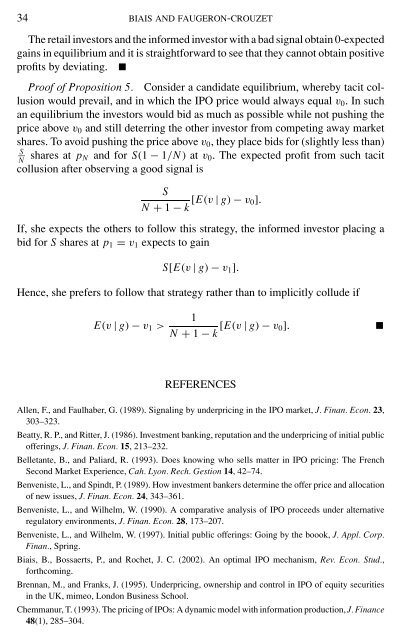34 BIAIS AND FAUGERON-CROUZET The retail investors <strong>and</strong> the informed investor with a bad signal obtain 0-expected gains in equilibrium <strong>and</strong> it is straightforward to see that they cannot obtain positive profits by deviating. Proof of Proposition 5. Consider a c<strong>and</strong>idate equilibrium, whereby tacit collusion would prevail, <strong>and</strong> in which the <strong>IPO</strong> price would always equal v0. In such an equilibrium the investors would bid as much as possible while not pushing the price above v0 <strong>and</strong> still deterring the other investor from competing away market shares. To avoid pushing the price above v0, they place bids for (slightly less than) S N shares at pN <strong>and</strong> for S(1 − 1/N) atv0. The expected profit from such tacit collusion after observing a good signal is S [E(v | g) − v0]. N + 1 − k If, she expects the others to follow this strategy, the informed investor placing a bid for S shares at p1 = v1 expects to gain S[E(v | g) − v1]. Hence, she prefers to follow that strategy rather than to implicitly collude if E(v | g) − v1 > 1 [E(v | g) − v0]. N + 1 − k REFERENCES Allen, F., <strong>and</strong> Faulhaber, G. (1989). Signaling by underpricing in the <strong>IPO</strong> market, J. Finan. Econ. 23, 303–323. Beatty, R. P., <strong>and</strong> Ritter, J. (1986). Investment banking, reputation <strong>and</strong> the underpricing of initial public offerings, J. Finan. Econ. 15, 213–232. Belletante, B., <strong>and</strong> Paliard, R. (1993). Does knowing who sells matter in <strong>IPO</strong> pricing: The <strong>French</strong> Second Market Experience, Cah. Lyon. Rech. Gestion 14, 42–74. Benveniste, L., <strong>and</strong> Spindt, P. (1989). How investment bankers determine the offer price <strong>and</strong> allocation of new issues, J. Finan. Econ. 24, 343–361. Benveniste, L., <strong>and</strong> Wilhelm, W. (1990). A comparative analysis of <strong>IPO</strong> proceeds under alternative regulatory environments, J. Finan. Econ. 28, 173–207. Benveniste, L., <strong>and</strong> Wilhelm, W. (1997). Initial public offerings: Going by the boook, J. Appl. Corp. Finan., Spring. Biais, B., Bossaerts, P., <strong>and</strong> Rochet, J. C. (2002). An optimal <strong>IPO</strong> mechanism, Rev. Econ. Stud., forthcoming. Brennan, M., <strong>and</strong> Franks, J. (1995). Underpricing, ownership <strong>and</strong> control in <strong>IPO</strong> of equity securities in the UK, mimeo, London Business School. Chemmanur, T. (1993). The pricing of <strong>IPO</strong>s: A dynamic model with information production, J. Finance 48(1), 285–304.
<strong>IPO</strong> AUCTIONS 35 Cornelli, F., <strong>and</strong> Goldreich, D. (1998). Book building <strong>and</strong> strategic allocation, working paper, London Business School. Derrien, F., <strong>and</strong> Womack, K. (1999). <strong>Auctions</strong> versus Book Building <strong>and</strong> the control of underpricing in hot <strong>IPO</strong> markets, Working paper, Dartmouth College. Dubois, M. (1989). Les entreprises qui s’introduisent en Bourse sont-elles sous évaluées? J. Soc. Stat. Paris 130(1), 4–616. Grinblatt, M., <strong>and</strong> Hwang, C. (1989). Signalling <strong>and</strong> the pricing of new issues, J. Finance 44(2), 393–420. Hanley, K. (1993). The underpricing of initial public offerings <strong>and</strong> the partial adjustment phenomenon, J. Finan. Econ. 231–250. Hanley, K., <strong>and</strong> Wilhelm, W. (1995). Evidence on the strategic allocation of <strong>IPO</strong>, J. Finan. Econ. 239–257. Hanley, K., Lee, C., <strong>and</strong> Seguin, P. (1996). The marketing of closed end fund <strong>IPO</strong>s: Evidence from transactions data, J. Finan Intermediation 5, 127–159. Husson, B., <strong>and</strong> Jacquillat, B. (1989). <strong>French</strong> new issues, underpricing, <strong>and</strong> alternative methods of distribution, in “A Reappraisal of the Efficiency of Financial Markets” (R. Guimaraes et al., Eds.). Springer Verlag, Berlin. Husson, B., <strong>and</strong> Jacquillat, B. (1990). Sous-évaluation des titres et méthodes d’introduction au second marché (1983–1986), Finance 11(1). Ibbotson, R. (1975). Price performance of common stock new issues, J. Finan. Econ. 235–272. Ibbotson, R., Sindelar J., <strong>and</strong> Ritter, J. (1988). Initial public offerings, J. Appl. Corp. Finan. 1(4), 37–45. Jacquillat, B., <strong>and</strong> Mac Donald, J. G. (1974). L’efficacité de la procédure française d’introduction en Bourse, Rev. Banque 31–39. Jacquillat, B., Mac Donald, J. G., <strong>and</strong> Rolfo, J. (1978). <strong>French</strong> auctions of common stock: New issues, J. Bus. Finan. 2, 305–322. K<strong>and</strong>el, S., Sarig, O., <strong>and</strong> Wohl, A. (1997). The dem<strong>and</strong> for stocks: An analysis of <strong>IPO</strong> auctions, Working paper, Tel Aviv University. Keloharju, M. (1993). The winner’s curse, legal liability, <strong>and</strong> the long run price performance of initial public offerings in Finl<strong>and</strong>, J. Finan. Econ. 251–277. Koh, F., <strong>and</strong> Walter, T. (1989). A direct test of Rock’s model of the pricing of unseasoned issues, J. Finan. Econ. 251–272. Leleux, B. (1993). Post–<strong>IPO</strong> performance: A <strong>French</strong> appraisal, Finance 14(2), 79–105. Levis, M. (1990). The winner’s curse problem, interest costs <strong>and</strong> the underpricing of initial public offerings, Econ. J. 76–89. Loughran, T., Ritter, J., <strong>and</strong> Rydqvist, K. (1994). Initial public offering: International insights, Pacific- Basin Finan. J. 2, 165–199. Michaely, R., <strong>and</strong> Shaw, W. (1993). The pricing of initial public offerings: Tests of adverse selection <strong>and</strong> signalling theories, Rev. Finan. Stud. 7(2). Mirat, B. (1983). Les Introductions sur le Second Marché, Banque 1127–1134. Mirat, B. (1984). Les Introductions sur le Second Marché (1983–1984), Banque 1027–1035; 1148–1156. Ritter, J. (1984). The hot issue market of 1980, J. Bus. 57, 215–240. Rock, K. (1986). Why new issues are underpriced, J. Finan. Econ. 15, 187–212. Sherman, A. (1999). Global trends in <strong>IPO</strong> methods: Book Building versus auctions, working paper, University of Minnesota. Sherman, A. (2000). <strong>IPO</strong>s <strong>and</strong> long term relationships, Rev. Finan. Stud. 13(3), 697–710. Smith, C. (1986). Investment banking <strong>and</strong> the capital acquisition process, J. Finan. Econ. 15, 3–29.
















